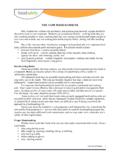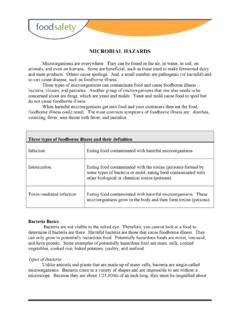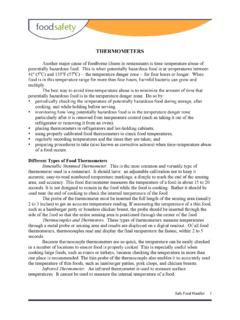Transcription of PURCHASING AND RECEIVING - Food safety
1 PURCHASING AND RECEIVING . The flow of food is the steps that food goes through from the time the food is received until the time that it is served. If food is not handled safely at each step, contamination or bacterial growth could occur. Three common flow charts are: 1. RECEIVING Storage Serving 2. RECEIVING Storage Preparation Cooking Holding Serving 3. RECEIVING Storage Preparation Cooking Cooling Reheating Serving Your food safety plan should address how you will keep food safe at each step. Therefore, food safety and standard operating procedures need to be developed for each step. The first step is develop procedures to determine if a food is safe upon receipt. Safe and Approved Food Source The first line of defense in preventing foodborne illness is to obtain food from safe and approved sources. Safe and approved sources are suppliers that comply with pertinent laws and regulations.
2 The only exception is that fresh, whole, uncut produce can come from any source, including roadside vendors, Farmer's Market, and local gardens. Never use home prepared or home canned food in your restaurant as it is not known if it was safely prepared. Inspect before You Accept Inspect foods to reduce your risk for foodborne illness and to be sure that food is safe. Check delivery vehicles for cleanliness and proper temperature control. Dirty vehicles could contaminate food. Never accept food that has been shipped in a vehicle that has carried live animals or harmful substances. If these vehicles must be used, they must be thoroughly washed, rinsed, and sanitized before they are used to transport food. Temperature-controlled vehicles must be at the proper temperature. Vehicles used to transport refrigerated foods must be at 41oF (5oC) or colder.
3 Vehicles used to transport frozen foods must be at 0oF (-18oC) or colder; and Vehicles used to transport hot foods must be at 135oF (57oC) or hotter. Inspect all deliveries before you accept them. It is important to have a list of criteria that you or your workers will use to determine if the food will be accepted or rejected. The food worker who accepts food deliveries must be trained on how to use this criteria. Other considerations Shellstock is raw molluscan shellfish still in their shell. Molluscan shellfish include oysters, clams, mussels, and scallops. Shellstock tags must remain attached to the container until the container is empty. They must be kept on file for 90 calendar days from the date the container is emptied. Safe Food Handler 1. Criteria for Accepting or Rejecting a Food Delivery FOOD Criteria to Accept Delivery Meat and Poultry 41oF (5oC) or colder.
4 Obtained from an approved source. Stamped with USDA inspection stamp. Good color and no odor. Packaging clean and in good condition. Seafood 41oF (5oC) or colder. Obtained from an approved source. Good color and no off-odors. Packaging clean and in good condition. Shellfish 45oF (7oC) or colder. Obtained from approved source. Clean, shells closed, and no broken shells. Shellstock tags must be readable and attached. Crustacea 45oF (7oC) or colder. Obtained from an approved source. Fresh produce Clean and good condition. If produce is cut or processed, it is at 41oF. or colder. Dairy Products 41oF (5oC) or colder unless labeled otherwise. Obtained from an approved source. Packaging clean and in condition. All products are pasteurized. Eggs Shell eggs at 45oF (7oC) or colder; liquid eggs at 41oF (5oC) or colder. Shell eggs -- clean and uncracked; frozen, and dry eggs.
5 Pasteurized. Obtained from an approved source. Refrigerated and frozen 41oF (5oC) or colder; if frozen, the product is rock solid. Packaging processed food clean and in good condition. Obtained from an approved source. MAP If the product requires refrigeration, it is at 41oF (5oC) or colder. Obtained from an approved source. Packaging clean and in good condition. Labels can be read and attached to the product. Canned food Obtained from an approved source. No swollen ends, leaks, rust, dents. Label can be read and is attached to the product. Dry foods Obtained from an approved source. Packaging clean and in good condition. No signs of pest infestation. UHT Obtained from an approved source. Packaging clean and in good condition. If product requires refrigeration, it is at 41oF (5oC) or colder. Label is attached and can be read. PURCHASING 2.
6 Criteria for Accepting or Rejecting a Food Delivery (continued). FOOD Criteria to Accept Delivery Baked Goods Obtained from an approved source. Packaging clean and in good condition. Products are not moldy. Potentially Hazardous Obtained from an approved source. Temperature at 135oF (57oC) or Hot Foods hotter. Holding containers are clean and in good condition. Prepared by: Angela M. Fraser, , Associate Professor/Food safety Specialist Department of Family and Consumer Sciences NC State University, Raleigh, NC 27695-7605. The material in this fact sheet, unless otherwise identified, is based upon work supported by the Extension Service, Department of Agriculture, under special project number 2003-51110-01715, the National Integrated Food safety Initiative of the Integrated Research, Education, and Extension Competitive Grants Program.
7 For more information, contact Dr. Angela Fraser at 919-515-9150 or at Employment and program opportunities are offered to all people regardless of race, color, national origin, sex, age, or disability through North Carolina State University, North Carolina A & T State University, Department of Agriculture, and local governments cooperating. PURCHASING 3.






